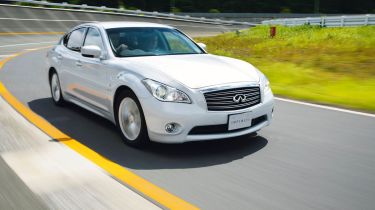Infiniti M35h
Verdict on new petrol-electric saloon
If you’re a fan of Infiniti’s styling, then the M35h hybrid has a lot going for it. Not only is it quick, it’s also economical, and it appears to rely on battery power more regularly than other petrol-electric cars. Perhaps most impressive is the minimal extra cost over the diesel, as well as the high standard equipment count compared to many rivals. At nearly £47,000, it’s not cheap, but you do get a lot of car for the money.
Does a hybrid petrol Infiniti make sense? We took to the road to find out. At the start of 2011, petrol power was the only option on the firm’s large M saloon. By September, there will be three variants, with the hybrid M35h joining the diesel model in UK dealers. And Infiniti reckons it won’t be long before the petrol-electric version accounts for nearly half of its saloon sales.
It’s easy to see why – it will assume the position of being the firm’s fastest, most economical model. Despite these accolades, it’s hard to tell the M35h apart from the more conventionally powered machines; discreet badges are the only clues.
You might have more success identifying it by the noise it makes. This is the first hybrid to have a special speaker at front air intake height. At low speeds in electric mode, it emits a cross between a whir and a whoosh, to warn pedestrians of the car’s impending arrival.
Used - available now

2023 Kia
Sportage
7,596 milesAutomaticPetrol1.6L
Cash £27,197
2023 Hyundai
Tucson
15,669 milesAutomaticPetrol1.6L
Cash £23,197
2023 Audi
Q3
55,572 milesAutomaticDiesel2.0L
Cash £22,197
2023 Audi
A3 Sportback
11,168 milesManualPetrol1.0L
Cash £18,197That isn’t the only novelty.
The Infiniti uses a new Direct Response Hybrid System that employs two clutches between the regular 3.5-litre petrol engine and the rear wheels. These sandwich the electric motor, and mean the system is able to charge and discharge more smoothly by eliminating the friction when going from propulsion to generation and petrol-only to electric modes.
The system works seamlessly, and because of its efficiency is more powerful than those of rivals. In addition, the M35h can run at up to 62mph on electricity alone. In reality, it doesn’t get there on electric propulsion, but once the petrol engine has taken the car up to cruising speed, you see the rev counter needle drop to zero as battery power takes over for cruising. It’s hard to tell when the petrol unit cuts in and out, and only the regenerative braking system causes any jerkiness.
One area where the hybrid suffers compared to a regular M saloon is in boot space, which is down by 150 litres. However, because lithium-ion batteries are used rather than nickel metal hydride ones, the load area isn’t as small as that found in the rival Lexus GS 450h.
And with a price premium of only £1,180, plus an enormous kit list, the Japanese firm’s products are starting to make an increasing amount of sense.



